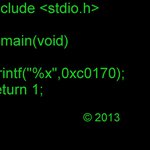This is a very simple guide, reviewing the steps required to get Blinky working on an Mbed OS platform.
Mbed OS Blinky
This example shows the use of a DigitalOut object to represent an LED and use of the nonblocking Thread::wait() call. Using nonblocking calls is good practice because Mbed OS can schedule and run other threads while the first thread is waiting.
Building this example
Building with Arm Mbed CLI
To use Mbed CLI to build this example, follow the instructions in the documentation. The instructions here relate to using the Arm Online Compiler.
To use the Online Compiler, import this code into the Online Compiler, and select your platform from the top right. Compile the code using the compile button, load it onto your board and press the reset button on the board. The code will run on the board, and you will see the LED blink.
You can find more instructions for using the Mbed Online Compiler in the documentation.
Diff: README.md
- Revision:
- 88:bea4f2daa48c
- Parent:
- 85:b4c5dbbf74e3
- Child:
- 89:448e37ce650a
--- a/README.md Mon Jan 07 12:00:02 2019 +0000 +++ b/README.md Tue Jan 08 12:45:03 2019 +0000 @@ -110,9 +110,7 @@ ### Output -To view the serial output you can use any terminal client of your choosing such as [PuTTY](http://www.putty.org/) or [CoolTerm](http://freeware.the-meiers.org/). - -The default baud rate for this application is set to `115200` and may be modified in the `mbed_app.json` file. +To view the serial output you can use any terminal client of your choosing such as [PuTTY](http://www.putty.org/) or [CoolTerm](http://freeware.the-meiers.org/). Unless otherwise specified, printf defaults to a baud rate of 9600 on Mbed OS. You can find more information on the Mbed OS configuration tools and serial communication in Mbed OS in the related [related links section](#related-links).
 mbed-os-examples
mbed-os-examples


 L-Tek FF1705
L-Tek FF1705